FMS – Functional Movement Screen
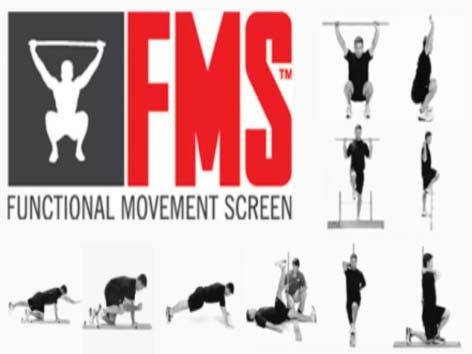
CHE COSA E’?
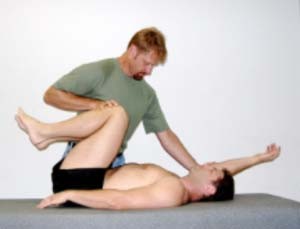 Il Functional Movement Screen (Scrutinio dei Movimenti Funzionali) è una batteria di sette test che valuta la competenza del soggetto nell’esecuzione dei movimenti funzionali di base.
Il Functional Movement Screen (Scrutinio dei Movimenti Funzionali) è una batteria di sette test che valuta la competenza del soggetto nell’esecuzione dei movimenti funzionali di base.
È uno strumento standardizzato, affidabile e ripetibile (Moran et al, 2015; Bonazza et al, 2016) che permette di rilevare, dove presenti, le principali aree di carenza o scarso controllo del movimento e dimostrare limitazioni o asimmetrie.
Per capirci meglio, i movimenti di base sono quei movimenti (non sport specifici) che ogni individuo attivo dovrebbe essere in grado di
padroneggiare, gestendo mobilità, stabilità, propriocezione e coordinazione.
Se prendessimo in considerazione la Piramide della Performance (figura a fianco), ci stiamo riferendo al tassello più basso – MOVEMENT.
Maggiore è la competenza in questa fascia, migliore sarà l’efficienza degli allenamenti mirati alla parte atletica – PERFORMANCE – e alla parte sport specifica – SKILL – riducendo il rischio infortuni e sovraccarichi.
Diversamente dalla maggior parte dei test muscolari, l’FMS non valuta i singoli distretti ma sequenze di movimento che coinvolgono
parti corporee concatenate.
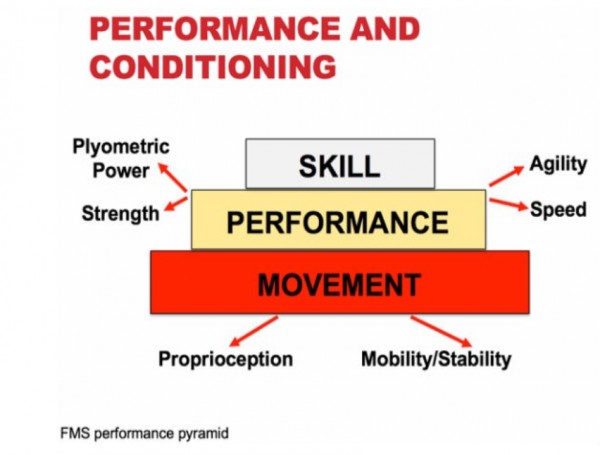 In definitiva è un ottimo strumento per:
In definitiva è un ottimo strumento per:
- giudicare performance e longevità atletica
- preservare l’economia del movimento
- identificare l’anello debole
- ridurre il rischio di infortuni da sovraccarico e lesioni muscolo-tendinee e legamentose
- guidare verso un lavoro correttivo personalizzato
- validare il soggetto o l’atleta al ritorno all’attività fisica o sportiva dopo una riabilitazione
- monitorare i risultati nel tempo
- stabilire un link diretto ed un linguaggio comune tra staff medico e preparatori
- integrare terapia manuale e allenamento sul campo o in palestra
UN PO’ DI STORIA…
Nasce nella seconda metà degli anni ’90 negli Stati Uniti dalla intuizione ed esperienza del terapista e trainer statunitense Grey Cook (PT, OCS, CSCS), collaboratore della nazionale olimpica di ginnastica statunitense, nonché ricercatore e autore di numerosi testi di fama internazionale. Il suo quesito di partenza è stato: per migliorare la prestazione del mio atleta, devo aumentargli il carico di lavoro o correggere il suo movimento?…e quali i parametri nel valutare la qualità del suo movimento?
Per trovare risposta alla sua domanda iniziò a collaborare con il suo collega Lee Burton (PhD, ATC, CSCS) nel strutturare una batteria di test che potesse essere un parametro il più oggettivo possibile nel valutare i movimenti di base.
Correggere o migliorare questi pattern, prima di allenarli e sovraccaricarli, avrebbe garantito che tutto il resto sarebbe stato svolto in maniera migliore e con minori rischi.
Così sperimentarono il loro lavoro con gli studenti dei college per quantificare la longevità atletica e stabilire chi avrebbe potuto avere più aspettative nella carriera sportiva; dato fondamentale anche per il valore economico del giocatore…da non sottovalutare!
I risultati balzarono agli occhi delle principali federazioni sportive statunitensi: ad oggi l’FMS è un punto di riferimento nell’ NBA, NFL, NHL, nonché oltreoceano nell’ambito del calcio, della pallavolo, del golf, del tennis e di molti altri sport.
COME FUNZIONA?
Tutto ciò è ottenuto ponendo il soggetto in posizioni in cui eventuali debolezze, squilibri, asimmetrie e limitazioni diventano evidenti agli occhi di operatori sanitari o trainer qualificati.
Non fornisce dunque il perchè delle disfunzioni, ma dà la possibilità di renderle evidenti in pochi minuti.
La forza dell’ FMS risiede nella sua semplicità e praticità, infatti le uniche cose di cui l’operatore ha bisogno sono:
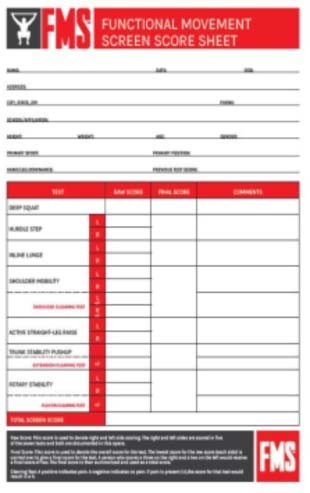 la scheda paziente
la scheda paziente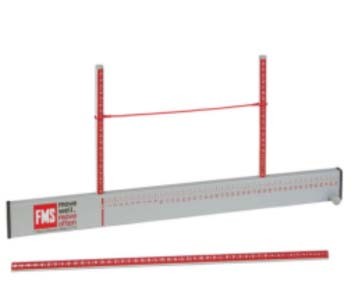 il kit di valutazione
il kit di valutazioneA questo punto non resta che dare brevi e chiare istruzioni all’utente sul movimento da eseguire ed osservare i suoi schemi motori.
Delle sette prove da eseguire, due pattern di movimento valutano principalmente la mobilità delle spalle e delle anche; altri due la stabilizzazione statica e dinamica; gli ultimi tre sono sequenze motorie più complesse e ci danno informazioni sulle capacità coordinative:
TEST MOBILITA’
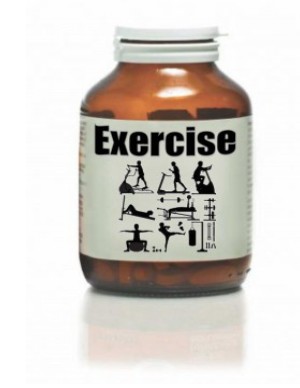 Shoulder Mobility (SM)
Shoulder Mobility (SM)
Active Straight Leg Raise (ASLR)
TEST STABILITA’
Trunk Stability Push Up (TSPU)
Rotary Stability (RS)
TEST CONTROLLO MOTORIO DINAMICO
Deep Squat (DS)
Hurdle Step (HS)
In Line Lunge (ILL)
All’interno di questi si aggiungono altri tre test di provocazione del dolore, uno per l’impingement scapolo omerale e due per la sensibilità lombare in flessione ed estensione.
PUNTEGGI
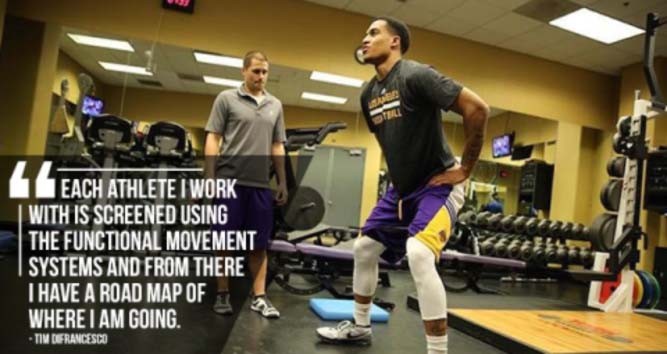 Alcuni pattern hanno un punteggio per la parte destra e la parte sinistra del corpo, mentre altri sono unici. I parametri presi in considerazione sono:
Alcuni pattern hanno un punteggio per la parte destra e la parte sinistra del corpo, mentre altri sono unici. I parametri presi in considerazione sono:
0= presenza di dolore in una qualsiasi parte del corpo
1= incapacità di completare la sequenza motoria richiesta, se non con l’utilizzo di molti compensi o perdita di equilibrio evidente
2= qualità del movimento sufficiente, seppur con la presenza di alcuni compensi in atto
3= qualità del movimento ottimale, senza compensi
STRATEGIE CORRETTIVE/TERAPEUTICHE
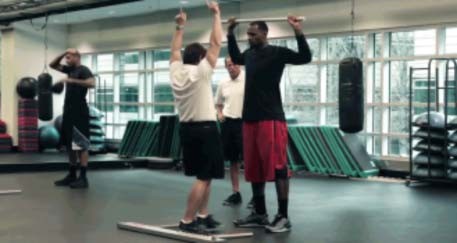 In una fase successiva l’operatore metterà insieme i dati raccolti e costruirà delle sequenze di esercizi correttivi che andranno a scomporre in maniera più semplice il movimento “compromesso”. Le strategie correttive seguiranno la logica che la mobilità è la priorità assoluta, seguita dall’esigenza di un controllo motorio con difficoltà crescente, per approdare infine agli esercizi specifici per la forza.
In una fase successiva l’operatore metterà insieme i dati raccolti e costruirà delle sequenze di esercizi correttivi che andranno a scomporre in maniera più semplice il movimento “compromesso”. Le strategie correttive seguiranno la logica che la mobilità è la priorità assoluta, seguita dall’esigenza di un controllo motorio con difficoltà crescente, per approdare infine agli esercizi specifici per la forza.
Una ulteriore scomposizione che verrà fatta nella scelta degli esercizi, terrà in considerazione le tappe evolutive di crescita del primo anno di vita, insite in ciascuno di noi. Prediligeremo, quindi, posizioni in :
- prono/supino,
- poi in quadrupedia
- poi in ginocchio
- infine in piedi
Nei casi in cui si manifestasse un dolore durante l’esecuzione del test, una lente di ingrandimento di tipo medico/sanitario servirà per indagare più a fondo sulla sequenza di movimento ed indirizzarci verso la strategia terapeutica più appropriata, PRIMA di proseguire con tutto il resto.
Inoltre l’utente avrà accesso ad una piattaforma virtuale, in cui avrà la possibilità di seguire i suoi risultati e consultare gli esercizi a lui assegnati
A CHI E’ RIVOLTO E PERCHE’?
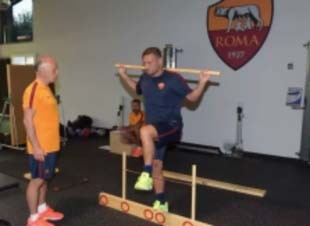 È rivolto a tutti gli sportivi, dall’adolescenza in poi, agonisti o dilettanti, ma soprattutto professionisti.
È rivolto a tutti gli sportivi, dall’adolescenza in poi, agonisti o dilettanti, ma soprattutto professionisti.
• Negli adulti dobbiamo considerare due principali componenti: la prima è legata agli infortuni pregressi, di come possano alterare le sequenze motorie di base e determinare l’instaurarsi di compensi, soprattutto se non trattati nella maniera migliore. È questo il campo di azione dell’FMS quando lo scopo è valutarle e renderle più efficienti.
La seconda è legata al gesto atletico sport-specifico: ricordiamoci sempre che uno sportivo d’elite compie il gesto specifico innumerevoli volte alla settimana, tanto da catalogare le patologie più frequenti in ogni settore. L’FMS in questo caso può essere di aiuto nell’identificare lo schema di movimento più sofferente e dare una mano all’atleta nel controbilanciamento muscolare, con l’auspicio di aumentare la longevità atletica.
• L’età adolescenziale è invece la più indicata per un fattore preventivo, in quanto le strategie di movimento dovranno ancora ben definirsi, oltre che per non ostacolare il normale processo di sviluppo scheletrico. Inoltre l’intensità di lavoro non troppo eccessiva (!) potrebbe e dovrebbe garantire lo spazio sufficiente da dedicare alla prevenzione.
In entrambi i casi è fondamentale porre tanta attenzione sulla consapevolezza di un movimento più efficiente.
In particolare:
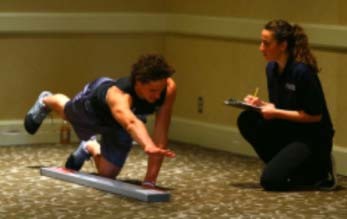 sportivi professionisti/agonisti per:
sportivi professionisti/agonisti per:
- ottenere il massimo delle performance, preservando il più possibile l’integrità muscolo-scheletrica, la longevità atletica e l’economia del movimento;
- monitorare l’impatto degli allenamenti, definendo un carico di lavoro ottimale;
- coadiuvare allenamento in palestra e sul campo;
- avere parametri di riferimento nel tempo;
- stabilire quando si è pronti a rientrare dopo un infortunio;
- prevenzione, core training e benessere posturale;
- interazione staff medico-staff tecnico
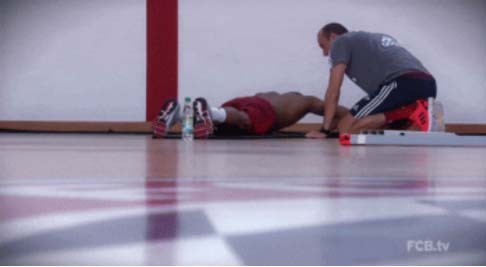 Per ulteriori informazioni visita il sito www.functionalmovement.com
Per ulteriori informazioni visita il sito www.functionalmovement.com
Per ulteriori chiarimenti o appuntamenti:
Dott. Nicola Basile 328 088 4976 mail: Questo indirizzo email è protetto dagli spambots. È necessario abilitare JavaScript per vederlo.;
Spine Center 051 095 2375 via della Liberazione 5, Bologna; www.spine-center.it
BIBLIOGRAFIA
– Abraham A, Sannasi R, Nair R. Normative values for the functional movement screentm in adolescent school aged children. Int J Sports Phys Ther. 2015 Feb;10(1):29-36. PubMed PMID: 25709860; PubMed Central PMCID: PMC4325285.
– Agresta C, Slobodinsky M, Tucker C. Functional movement ScreenTM—normative values in healthy distance runners. Int J Sports Med. 2014 Dec;35(14):1203-7. doi: 10.1055/s-0034-1382055. Epub 2014 Aug 21. PubMed PMID: 25144432.
– Anderson BE, Neumann ML, Huxel Bliven KC. Functional movement screen differences between male and female secondary school athletes. J Strength Cond Res. 2015 Apr;29(4):1098-106. doi: 10.1519/JSC.0000000000000733. PubMed PMID: 25330082.
– Beach TA, Frost DM, Callaghan JP. FMS™ scores and low-back loading during lifting–whole-body movement screening as an ergonomic tool? Appl Ergon. 2014 May;45(3):482-9.doi: 10.1016/j.apergo.2013.06.009. Epub 2013 Jul 20. PubMed PMID: 23876984.
– Beach TA, Frost DM, McGill SM, Callaghan JP. Physical fitness improvements and occupational low-back loading – an exercise intervention study with firefighters. Ergonomics. 2014;57(5):744-63. doi: 10.1080/00140139.2014.897374. Epub 2014 Apr 2. PubMed PMID: 24689834.
– Bodden JG, Needham RA, Chockalingam N. The effect of an intervention program on functional movement screen test scores in mixed martial arts athletes. J Strength Cond Res. 2015 Jan;29(1):219-25. doi: 10.1519/JSC.0b013e3182a480bf. PubMed PMID: 23860293.
– Boyle MJ, Butler RJ, Queen RM. Functional Movement Competency and Dynamic Balance After Anterior Cruciate Ligament Reconstruction in Adolescent Patients. J Pediatr Orthop. 2015 Jan 28. [Epub ahead of print] PubMed PMID: 25633606.
– Bradley H, Esformes J. Breathing pattern disorders and functional movement. Int J Sports Phys Ther. 2014 Feb;9(1):28-39. PubMed PMID: 24567853; PubMed Central PMCID: PMC3924606.
– Butler RJ, Contreras M, Burton LC, Plisky PJ, Goode A, Kiesel K. Modifiable risk factors predict injuries in firefighters during training academies. Work. 2013 Jan 1;46(1):11-7. doi: 10.3233/WOR-121545. PubMed PMID: 23324700.
– Butler RJ, Plisky PJ, Southers C, Scoma C, Kiesel KB. Biomechanical analysis of the different classifications of the Functional Movement Screen deep squat test. Sports Biomech. 2010 Nov;9(4):270-9. doi: 10.1080/14763141.2010.539623. PubMed PMID: 21309301.
– Chapman RF, Laymon AS, Arnold T. Functional movement scores and longitudinal performance outcomes in elite track and field athletes. Int J Sports Physiol Perform. 2014 Mar;9(2):203-11. doi: 10.1123/ijspp.2012-0329. Epub 2013 Apr 23. PubMed PMID: 23630121.
– Chimera NJ, Smith CA, Warren M. Injury history, sex, and performance on the functional movement screen and y balance test. J Athl Train. 2015 May;50(5):475-85. doi: 10.4085/1062-6050-49.6.02. Epub 2015 Mar 11. PubMed PMID: 25761134.
– Clifton DR, Harrison BC, Hertel J, Hart JM. Relationship between functional assessments and exercise-related changes during static balance. J Strength Cond Res. 2013 Apr;27(4):966-72. doi: 10.1519/JSC.0b013e318260b723. PubMed PMID: 22692124.
– Cook G, Burton L, Hoogenboom BJ, Voight M. Functional movement screening: the use of fundamental movements as an assessment of function – part 1. Int J Sports Phys Ther. 2014 May;9(3):396-409. PubMed PMID: 24944860; PubMed Central PMCID: PMC4060319.
– Cook G, Burton L, Hoogenboom BJ, Voight M. Functional movement screening: the use of fundamental movements as an assessment of function-part 2. Int J Sports Phys Ther. 2014 Aug;9(4):549-63. PubMed PMID: 25133083; PubMed Central PMCID: PMC4127517.
– Cook G, Burton L, Hoogenboom B. Pre-participation screening: the use of fundamental movements as an assessment of function – part 1. N Am J Sports Phys Ther. 2006 May;1(2):62-72. PubMed PMID: 21522216; PubMed Central PMCID: PMC2953313.
– Cook G, Burton L, Hoogenboom B. Pre-participation screening: the use of fundamental movements as an assessment of function – part 2. N Am J Sports Phys Ther. 2006 Aug;1(3):132-9. PubMed PMID: 21522225; PubMed Central PMCID: PMC2953359.
– Cowen VS. Functional fitness improvements after a worksite-based yoga initiative. J Bodyw Mov Ther. 2010 Jan;14(1):50-4. doi: 10.1016/j.jbmt.2009.02.006. Epub . PubMed PMID: 20006289.
– Dossa K, Cashman G, Howitt S, West B, Murray N. Can injury in major junior hockey players be predicted by a pre-season functional movement screen – a prospective cohort study. J Can Chiropr Assoc. 2014 Dec;58(4):421-7. PubMed PMID: 25550667; PubMed Central PMCID: PMC4262798.
– Duncan MJ, Stanley M, Leddington Wright S. The association between functional movement and overweight and obesity in British primary school children. BMC Sports Sci Med Rehabil. 2013 May 15;5:11. doi: 10.1186/2052-1847-5-11. eCollection 2013. PubMed PMID: 23675746; PubMed Central PMCID: PMC3656805.
– Duncan MJ, Stanley M. Functional movement is negatively associated with weight status and positively associated with physical activity in british primary school children. J Obes. 2012;2012:697563. doi: 10.1155/2012/697563. Epub 2012 Mar 26. PubMed PMID: 22545208; PubMed Central PMCID: PMC3321567.
– Elias JE. The Inter-rater Reliability of the Functional Movement Screen within an athletic population using Untrained Raters. J Strength Cond Res. 2013 Jul 8. [Epub ahead of print] PubMed PMID: 23838983.
– Fox D, O’Malley E, Blake C. Normative data for the Functional Movement Screen in male Gaelic field sports. Phys Ther Sport. 2014 Aug;15(3):194-9. doi: 10.1016/j.ptsp.2013.11.004. Epub 2013 Nov 20. PubMed PMID: 24556034.
– Frost DM, Beach TA, Callaghan JP, McGill SM. FMS™ scores change with performers’ knowledge of the grading criteria – Are general whole-body movement screens capturing “dysfunction”? J Strength Cond Res. 2013 Nov 20. [Epub ahead of print] PubMed PMID: 24263651.
– Frost DM, Beach TA, Callaghan JP, McGill SM. Using the Functional Movement Screen™ to evaluate the effectiveness of training. J Strength Cond Res. 2012 Jun;26(6):1620-30. doi: 10.1519/JSC.0b013e318234ec59. PubMed PMID: 21921825.
– Garrison M, Westrick R, Johnson MR, Benenson J. Association between the functional movement screen and injury development in college athletes. Int J Sports Phys Ther. 2015 Feb;10(1):21-8. PubMed PMID: 25709859; PubMed Central PMCID: PMC4325284.
– Goss DL, Christopher GE, Faulk RT, Moore J. Functional training program bridges rehabilitation and return to duty. J Spec Oper Med. 2009 Spring;9(2):29-48. PubMed PMID: 19813517.
– Gribble PA, Brigle J, Pietrosimone BG, Pfile KR, Webster KA. Intrarater reliability of the functional movement screen. J Strength Cond Res. 2013 Apr;27(4):978-81. doi: 10.1519/JSC.0b013e31825c32a8. PubMed PMID: 22592177.
– Gulgin H, Hoogenboom B. The functional movement screening (fms)™: an inter-rater reliability study between raters of varied experience. Int J Sports Phys Ther. 2014 Feb;9(1):14-20. PubMed PMID: 24567851; PubMed Central PMCID: PMC3924604.
– Hartigan EH, Lawrence M, Bisson BM, Torgerson E, Knight RC. Relationship of the functional movement screen in-line lunge to power, speed, and balance measures. Sports Health. 2014 May;6(3):197-202. doi: 10.1177/1941738114522412. PubMed PMID: 24790688; PubMed Central PMCID: PMC4000474.
– Hotta T, Nishiguchi S, Fukutani N, Tashiro Y, Adachi D, Morino S, Shirooka H, Nozaki Y, Hirata H, Yamaguchi M, Aoyama T. Functional Movement Screen for Predicting Running Injuries in 18-24 Year-Old Competitive Male Runners. J Strength Cond Res. 2015 Apr 3. [Epub ahead of print] PubMed PMID: 25853918.
– Kazman JB, Galecki JM, Lisman P, Deuster PA, OʼConnor FG. Factor structure of the functional movement screen in marine officer candidates. J Strength Cond Res. 2014 Mar;28(3):672-8. doi: 10.1519/JSC.0b013e3182a6dd83. PubMed PMID: 23924891.
– Kiesel K, Plisky P, Butler R. Functional movement test scores improve following a standardized off-season intervention program in professional football players. Scand J Med Sci Sports. 2011 Apr;21(2):287-92. doi: 10.1111/j.1600-0838.2009.01038.x. PubMed PMID: 20030782.
– Kiesel K, Plisky PJ, Voight ML. Can Serious Injury in Professional Football be Predicted by a Preseason Functional Movement Screen? N Am J Sports Phys Ther. 2007 Aug;2(3):147-58. PubMed PMID: 21522210; PubMed Central PMCID: PMC2953296.
– Kiesel KB, Butler RJ, Plisky PJ. Prediction of injury by limited and asymmetrical fundamental movement patterns in american football players. J Sport Rehabil. 2014 May;23(2):88-94. doi: 10.1123/jsr.2012-0130. Epub 2013 Nov 14. PubMed PMID: 24225032.
– Kraus K, Schütz E, Taylor WR, Doyscher R. Efficacy of the functional movement screen: a review. J Strength Cond Res. 2014 Dec;28(12):3571-84. doi: 10.1519/JSC.0000000000000556. PubMed PMID: 24918299.
– Krause DA, Boyd MS, Hager AN, Smoyer EC, Thompson AT, Hollman JH. Reliability and accuracy of a goniometer mobile device application for video measurement of the functional movement screen deep squat test. Int J Sports Phys Ther. 2015 Feb;10(1):37-44. PubMed PMID: 25709861; PubMed Central PMCID: PMC4325286.
– Krumrei K, Flanagan M, Bruner J, Durall C. The accuracy of the functional movement screen to identify individuals with an elevated risk of musculoskeletal injury. J Sport Rehabil. 2014 Nov;23(4):360-4. doi: 10.1123/jsr.2013-0027. Epub 2014 Jan 21. PubMed PMID: 24458441.
– Letafatkar A, Hadadnezhad M, Shojaedin S, Mohamadi E. Relationship between functional movement screening score and history of injury. Int J Sports Phys Ther. 2014 Feb;9(1):21-7. PubMed PMID: 24567852; PubMed Central PMCID: PMC3924605.
– Li Y, Wang X, Chen X, Dai B. Exploratory factor analysis of the functional movement screen in elite athletes. J Sports Sci. 2015 Jun;33(11):1166-72. doi: 10.1080/02640414.2014.986505. Epub 2014 Dec 3. PubMed PMID: 25465117.
– Lisman P, O’Connor FG, Deuster PA, Knapik JJ. Functional movement screen and aerobic fitness predict injuries in military training. Med Sci Sports Exerc. 2013 Apr;45(4):636-43. doi: 10.1249/MSS.0b013e31827a1c4c. PubMed PMID: 23190584.
– Lloyd RS, Oliver JL, Radnor JM, Rhodes BC, Faigenbaum AD, Myer GD. Relationships between functional movement screen scores, maturation and physical performance in young soccer players. J Sports Sci. 2015;33(1):11-9. doi: 10.1080/02640414.2014.918642. Epub 2014 May 23. PubMed PMID: 24857046.
– Lockie R, Schultz A, Callaghan S, Jordan C, Luczo T, Jeffriess M. A preliminary investigation into the relationship between functional movement screen scores and athletic physical performance in female team sport athletes. Biol Sport. 2015 Mar;32(1):41-51. doi: 10.5604/20831862.1127281. Epub 2014 Nov 3. PubMed PMID: 25729149; PubMed Central PMCID: PMC4314603.
– Lockie RG, Schultz AB, Jordan CA, Callaghan SJ, Jeffriess MD, Luczo TM. Can selected functional movement screen assessments be used to identify movement deficiencies that could affect multidirectional speed and jump performance? J Strength Cond Res. 2015 Jan;29(1):195-205. doi: 10.1519/JSC.0000000000000613. PubMed PMID: 25028993.
– Loudon JK, Parkerson-Mitchell AJ, Hildebrand LD, Teague C. Functional movement screen scores in a group of running athletes. J Strength Cond Res. 2014 Apr;28(4):909-13. doi: 10.1097/JSC.0000000000000233. PubMed PMID: 24662154.
– Mayer SW, Queen RM, Taylor D, Moorman CT 3rd, Toth AP, Garrett WE Jr, Butler RJ. Functional Testing Differences in Anterior Cruciate Ligament Reconstruction Patients Released Versus Not Released to Return to Sport. Am J Sports Med. 2015 Apr 13. pii: 0363546515578249. [Epub ahead of print] PubMed PMID: 25868636.
– McCall A, Carling C, Davison M, Nedelec M, Le Gall F, Berthoin S, Dupont G. Injury risk factors, screening tests and preventative strategies: a systematic review of the evidence that underpins the perceptions and practices of 44 football (soccer) teams from various premier leagues. Br J Sports Med. 2015 May;49(9):583-589. doi: 10.1136/bjsports-2014-094104. Epub 2015 Jan 9. Review. PubMed PMID: 25576530; PubMed Central PMCID: PMC4413799.
– McCall A, Carling C, Nedelec M, Davison M, Le Gall F, Berthoin S, Dupont G. Risk factors, testing and preventative strategies for non-contact injuries in professional football: current perceptions and practices of 44 teams from various premier leagues. Br J Sports Med. 2014 Sep;48(18):1352-7. doi:
10.1136/bjsports-2014-093439. Epub 2014 May 16. PubMed PMID: 24837243.
– Minick KI, Kiesel KB, Burton L, Taylor A, Plisky P, Butler RJ. Interrater reliability of the functional movement screen. J Strength Cond Res. 2010 Feb;24(2):479-86. doi: 10.1519/JSC.0b013e3181c09c04. PubMed PMID: 20072050.
– Minthorn LM, Fayson SD, Stobierski LM, Welch CE, Anderso BE. An Individualized Training Program May Improve Functional Movement Patterns Among Adults. J Sport Rehabil. 2014 Jul 8. [Epub ahead of print] PubMed PMID: 25008102.
– Mitchell UH, Johnson AW, Adamson B. Relationship between functional movement screen scores, core strength, posture, and body mass index in school children in moldova. J Strength Cond Res. 2015 May;29(5):1172-9. doi: 10.1519/JSC.0000000000000722. PubMed PMID: 25719919.
– Okada T, Huxel KC, Nesser TW. Relationship between core stability, functional movement, and performance. J Strength Cond Res. 2011 Jan;25(1):252-61. doi: 10.1519/JSC.0b013e3181b22b3e. PubMed PMID: 20179652.
– Onate JA, Dewey T, Kollock RO, Thomas KS, Van Lunen BL, DeMaio M, Ringleb SI. Real-time intersession and interrater reliability of the functional movement screen. J Strength Cond Res. 2012 Feb;26(2):408-15. doi: 10.1519/JSC.0b013e318220e6fa. PubMed PMID: 22266547.
– Pacheco MM, Teixeira LA, Franchini E, Takito MY. Functional vs. Strength training in adults: specific needs define the best intervention. Int J Sports Phys Ther. 2013 Feb;8(1):34-43. PubMed PMID: 23439782; PubMed Central PMCID: PMC3578432.
– Palmer TG, Howell DM, Mattacola CG, Viele K. Self-perceptions of proximal stability as measured by the functional movement screen. J Strength Cond Res. 2013 Aug;27(8):2157-64. doi: 10.1519/JSC.0b013e318279f940. PubMed PMID: 23207886.
– Parchmann CJ, McBride JM. Relationship between functional movement screen and athletic performance. J Strength Cond Res. 2011 Dec;25(12):3378-84. doi: 10.1519/JSC.0b013e318238e916. PubMed PMID: 21964425.
– Parenteau-G E, Gaudreault N, Chambers S, Boisvert C, Grenier A, Gagné G, Balg F. Functional movement screen test: a reliable screening test for young elite ice hockey players. Phys Ther Sport. 2014 Aug;15(3):169-75. doi: 10.1016/j.ptsp.2013.10.001. Epub 2013 Oct 14. PubMed PMID: 24291023.
– Paszkewicz JR, McCarty CW, Van Lunen BL. Comparison of functional and static evaluation tools among adolescent athletes. J Strength Cond Res. 2013 Oct;27(10):2842-50. doi: 10.1519/JSC.0b013e3182815770. PubMed PMID: 23302750.
– Peate WF, Bates G, Lunda K, Francis S, Bellamy K. Core strength: a new model for injury prediction and prevention. J Occup Med Toxicol. 2007 Apr 11;2:3. PubMed PMID: 17428333; PubMed Central PMCID: PMC1865378.
– Perry FT, Koehle MS. Normative data for the functional movement screen in middle-aged adults. J Strength Cond Res. 2013 Feb;27(2):458-62. doi: 10.1519/JSC.0b013e3182576fa6. PubMed PMID: 22561971.
– Rowan CP, Kuropkat C, Gumieniak RJ, Gledhill N, Jamnik VK. Integration of the functional movement screen into the national hockey league combine. J Strength Cond Res. 2015 May;29(5):1163-71. doi: 10.1519/JSC.0000000000000757. PubMed PMID: 25719918.
– Schneiders AG, Davidsson A, Hörman E, Sullivan SJ. Functional movement screen normative values in a young, active population. Int J Sports Phys Ther. 2011 Jun;6(2):75-82. PubMed PMID: 21713227; PubMed Central PMCID: PMC3109893.
– Shultz R, Anderson SC, Matheson GO, Marcello B, Besier T. Test-retest and interrater reliability of the functional movement screen. J Athl Train. 2013 May-Jun;48(3):331-6. doi: 10.4085/1062-6050-48.2.11. Epub 2013 Feb 20. PubMed PMID: 23675792; PubMed Central PMCID: PMC3655746.
– Smith CA, Chimera NJ, Wright NJ, Warren M. Interrater and intrarater reliability of the functional movement screen. J Strength Cond Res. 2013 Apr;27(4):982-7. doi: 10.1519/JSC.0b013e3182606df2. PubMed PMID: 22692121.
– Song HS, Woo SS, So WY, Kim KJ, Lee J, Kim JY. Effects of 16-week functional movement screen training program on strength and flexibility of elite high school baseball players. J Exerc Rehabil. 2014 Apr 30;10(2):124-30. doi: 10.12965/jer.140101. eCollection 2014 Apr. PubMed PMID: 24877049; PubMed Central PMCID: PMC4025546.
– Sprague PA, Monique Mokha G, Gatens DR, Rodriguez R Jr. The relationship between glenohumeral joint total rotational range of motion and the functional movement screen™ shoulder mobility test. Int J Sports Phys Ther. 2014 Oct;9(5):657-64. PubMed PMID: 25328828; PubMed Central PMCID: PMC4196330.
– Sprague PA, Mokha GM, Gatens DR. Changes in functional movement screen scores over a season in collegiate soccer and volleyball athletes. J Strength Cond Res. 2014 Nov;28(11):3155-63. doi: 10.1519/JSC.0000000000000506. PubMed PMID: 24796980.
– Stobierski LM, Fayson SD, Minthorn LM, Valovich McLeod TC, Welch CE. Reliability of clinician scoring of the functional movement screen to assess movement patterns. J Sport Rehabil. 2015 May;24(2):219-22. doi: 10.1123/jsr.2013-0139. Epub 2014 Jul 23. PubMed PMID: 25054658.
– Teyhen DS, Shaffer SW, Butler RJ, Goffar SL, Kiesel KB, Rhon DI, Williamson JN, Plisky PJ. What Risk Factors Are Associated With Musculoskeletal Injury in US Army Rangers? A Prospective Prognostic Study. Clin Orthop Relat Res. 2015 May 27. [Epub ahead of print] PubMed PMID: 26013150.
– Teyhen DS, Shaffer SW, Lorenson CL, Greenberg MD, Rogers SM, Koreerat CM, Villena SL, Zosel KL, Walker MJ, Childs JC. Clinical measures associated with dynamic balance and functional movement. J Strength Cond Res. 2014 May;28(5):1272-83. doi: 10.1519/JSC.0000000000000272. PubMed PMID: 24755867.
– Teyhen DS, Riebel MA, McArthur DR, Savini M, Jones MJ, Goffar SL, Kiesel KB, Plisky PJ. Normative data and the influence of age and gender on power, balance, flexibility, and functional movement in healthy service members. Mil Med. 2014 Apr;179(4):413-20. doi: 10.7205/MILMED-D-13-00362. PubMed PMID: 24690966.
– Teyhen DS, Shaffer SW, Lorenson CL, Halfpap JP, Donofry DF, Walker MJ, Dugan JL, Childs JD. The Functional Movement Screen: a reliability study. J Orthop Sports Phys Ther. 2012 Jun;42(6):530-40. doi: 10.2519/jospt.2012.3838. Epub 2012 May 14. PubMed PMID: 22585621.
– Warren M, Smith CA, Chimera NJ. Association of the functional movement screen with injuries in division I athletes. J Sport Rehabil. 2015 May;24(2):163-70. doi: 10.1123/jsr.2013-0141. Epub 2014 Sep 8. PubMed PMID: 25203695.
– Whiteside D, Deneweth JM, Pohorence MA, Sandoval B, Russell JR, McLean SG, Zernicke RF, Goulet GC. Grading the Functional Movement Screen™: A Comparison of Manual (Real-Time) and Objective Methods. J Strength Cond Res. 2014 Aug 26. [Epub ahead of print] PubMed PMID: 25162646.
– Wright MD, Portas MD, Evans VJ, Weston M. The effectiveness of 4 weeks of fundamental movement training on functional movement screen and physiological performance in physically active children. J Strength Cond Res. 2015 Jan;29(1):254-61. doi: 10.1519/JSC.0000000000000602. PubMed PMID: 25072666.
– Zalai D, Panics G, Bobak P, Csáki I, Hamar P. Quality of functional movement patterns and injury examination in elite-level male professional football players. Acta Physiol Hung. 2015 Mar;102(1):34-42. doi: 10.1556/APhysiol.101.2014.010. PubMed PMID: 25481368.

